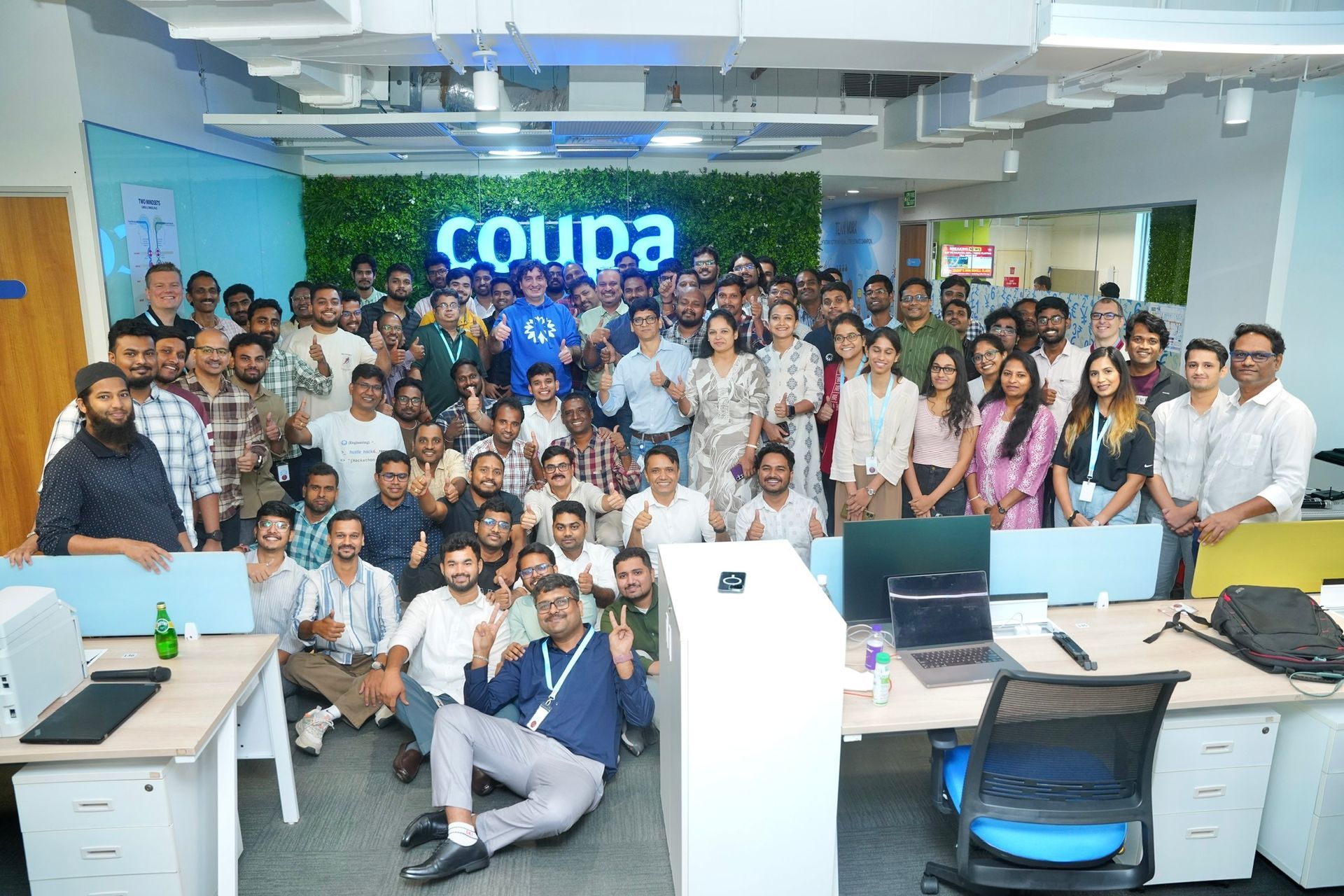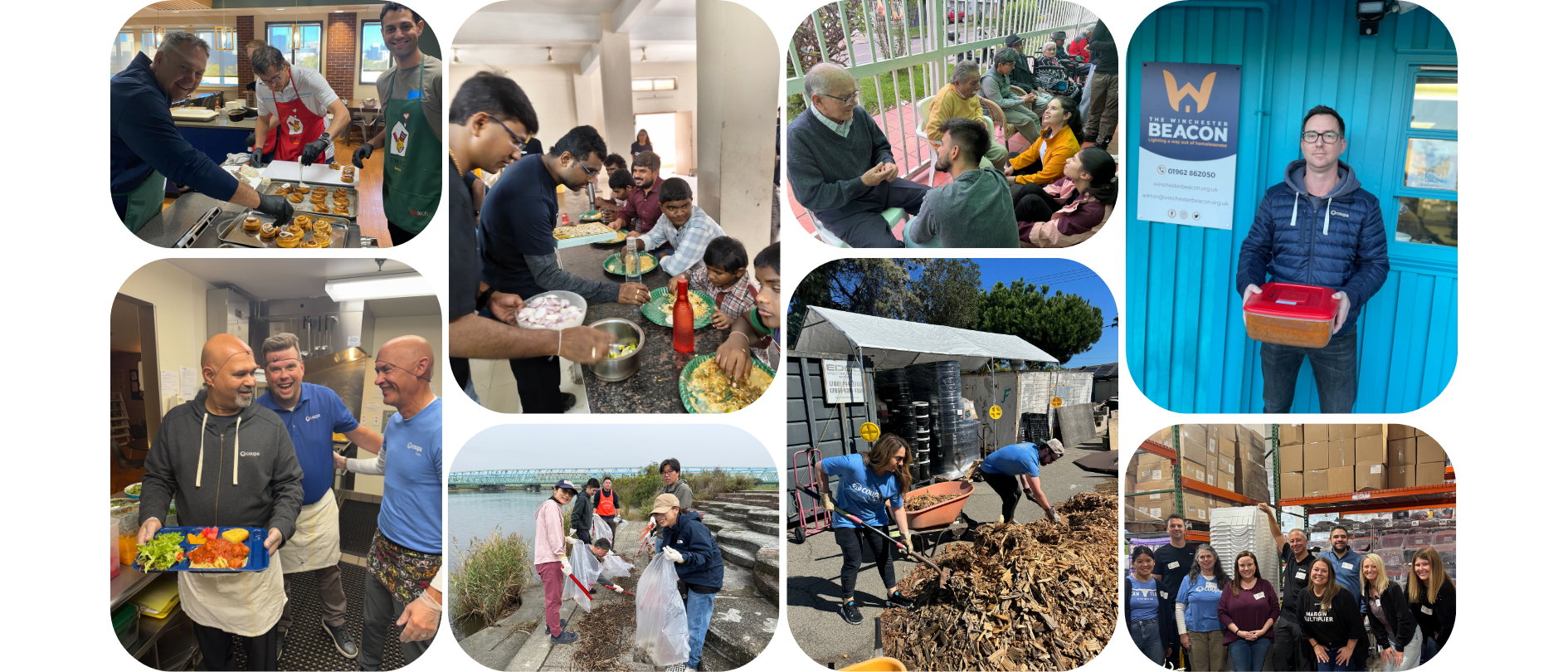How to Scale Engineering Teams from Startup to Corporate

How does an engineering team transition from a scrappy, startup mindset to think in terms of scale? It takes intentionality and strategy. As Coupa has transformed from a small organization to a leader in Business Spend Management, we have grown from a team of two engineers in 2006 to over 900 in the engineering team in 2022. Over the years, our teams have faced growing pains — as Coupa acquired companies, more people and more technologies had to mesh seamlessly together. Below are some of the best practices we have adopted to improve internal communication, improve code quality, and allow our engineers to quickly and efficiently add features.
When a software product is in an early stage and teams are small, design decisions can be made over a quick meeting, code reviews can be done by sitting next to each other, functional testing can be done manually, and deployments can be done at will. As teams grow in size and geographic location and the product matures and expands, communication and strategy on scaling the business becomes of utmost importance to avoid spaghetti code, performance lags, and siloed engineering teams with little integration.
9 ways engineering managers can scale their engineering teams
You may be asking yourself how to manage hundreds of developers, working across dozens of functional teams, across several time zones. It’s important to know where checks and balances should be implemented to ensure quality, efficiency, and knowledge transfers without hampering the speed and efficiency at which a startup operates.
1. Design reviews
At Coupa, all changes regardless of size go through a formal review process, focusing on the functional, technical, performance, and security aspects. Analyzing the impact of the change across the entire suite of software products is very important to prevent unwanted outcomes or confusion for our customers or other engineers trying to add a feature that touches unknown parts of the code or application. Subject matter experts review the changes internally first, and when needed these are lined up for a formal review by our principal architects.
2. Code reviews
To ensure that code being committed doesn’t negatively affect the system, all Github commits are required to have a pull request identifying what has changed and why. Depending on what kind of changes are made, the tool identifies various categories of reviewers to be assigned like API, UI, security, or migration. Reviewers don’t generally stop at finding problems, but they also support developers in making required changes. Reviewers are picked after a thorough evaluation process to ensure there are no loose ends.
3. Data table schemas and data migrations
As customer datasets grow, solutions must be built to allow for zero downtime schema changes. For example, engineers at Coupa built an internal tool which alters a table’s structure without blocking reads or writes to it. When data migration on these large sets of rows is required, Coupa uses a robust framework to divide and conquer the problem by distributing smaller chunks of work to multiple processes.
4. Performance
Keeping the performance implications of proposed changes in mind throughout the entire design and implementation phase of features will save many headaches near the end of a development phase. Coupa engineers have built a framework for testing pull requests on sanitized production data to get early feedback on performance implications. “Labs'’ simulate production scale load and test features to measure if the performance is affected by increased loads. Automations have been built to check the codebase of any increase in memory usage or app-bootup time at the end of every two-week sprint.
5. Reliability
Paired with performance, customers need to expect and trust the software’s reliability throughout each release. Teams at Coupa have KPIs like search response times, page load times, and error rates on calls to third party software that are reviewed regularly so that proper and timely corrections can be made. More importantly, teams should build safeguards around what customers can do with your application. Without these, customers may end up unknowingly exploiting our systems.
6. Code styling
Start-ups sometimes may be more focused releasing and short-term wins rather than long-term maintenance and code quality. To enforce the coding guidelines and standards outlined in the community as well as the company, Coupa engineers use static code analyzers like Rubocop or ESLint as well as code formatters. Reference this article on how to set up these tools.
7. Automation testing
Every pull request should pass the suite of existing tests to ensure the new functionality works as well as all previous functionality that is still intact. Not every part of the application can be tested via unit tests, so Coupa supplements the thousands of unit tests with additional test suites for UI / API / migration / end-to-end tests. Developers and reviewers must ensure appropriate coverage is added within the test suite for the new functionality being added.
8. Application security
Hands-on labs and annual mandatory compliance training should be put in place to make sure all developers know and understand the OWASP Top 10 Security Vulnerabilities that safeguard the application and customers’ data. Delivering a secure and scalable platform is a top priority and Coupa engineering goes above and beyond to ensure compliance so the entire Coupa community feels secure.
9. Release cycles
It’s very important to give customers adequate time to test and plan for upgrades. Coupa Engineering and Documentation teams work together to ensure that all code changes for major releases as well as continuous integration updates for customers are documented well and customers have been properly trained on what they can expect. By having this process in place we keep the channels of communication open and avoid unwanted setbacks.
Growing a global engineering team takes a great balance: productivity vs process. The goal is always to move at the rapid pace of a start-up but have smart (but not cumbersome) processes to keep all engineers informed about architecture and design changes as the team grows. And while Coupa is always #StrivingForExcellence and will never stop improving with that balance, hopefully some of these processes will help with your growing team.

AI Helps. People Hire. How Coupa Keeps Recruiting Human. By Chris Bartolo At Coupa, transformation is part of who we are. Whether it’s using our platform to help businesses run smarter or how people build meaningful careers with us, integrity is at our core. We also understand that the job search can feel both exciting and overwhelming. Generative AI (GenAI) has emerged as a helpful tool in the job hunt, but we want candidates to know one thing clearly: every hiring decision at Coupa is made by real people. AI can support your journey. It will never replace real connection, context, or the value of your lived experience. It’s great if AI tools help you feel more prepared. What matters most is you and what you uniquely bring to an opportunity. Here are a few simple guidelines to help you understand our position on the ethical use of AI throughout your application process. Tips for Using AI in Your Application Journey Use AI as a starting point, not the final version. AI can help brainstorm résumé or cover-letter ideas, but your application should reflect your true experience and voice which is what we care about. Lean into what makes you stand apart. AI can refine words, but only you can share the real story behind your work, impact, and growth. Prep with AI, but don’t script interviews. AI-generated mock questions can help you practice, but we want your thinking, not rehearsed answers. Stay truthful. Using AI to organize your ideas is great. Using it to stretch or fabricate experience isn’t. Show us your authentic self. Most important: people make the decisions. While we use tools to stay organized and communicate efficiently, a human reviews every application, interview, and decision. How Coupa Uses AI in the Hiring Process We use AI to improve efficiency and candidate experience, not to replace human judgment. Candidate Discovery Within our CRM (candidate relationship management) system, AI helps recruiters identify talent for current and future opportunities. It supports efficiency, but decisions are based on human evaluation of skills, experience, and potential. Job Descriptions Our talent and business teams craft every job description. Tech may help with clarity or grammar, but the content is built by people who understand the role, team, and business needs. Assessments Coupa does not use AI-powered assessments or automated decision-making tools. Every step of your application is reviewed by humans. Evaluation We do not—and will not—use AI to make or automate hiring decisions. Scheduling Our AI scheduling tools help streamline coordination and reduce time-to-hire by up to 25%, creating a smoother experience for both candidates and hiring teams. Our Commitment AI helps us work smarter, but people remain at the center of our hiring process. Our goal is a fair, thoughtful, human-centered experience for every applicant. As technology evolves, we’ll continue to use it responsibly and update our practices with transparency. Want to learn more? Check out Coupa Careers and join our vibrant Talent Community.

Talent isn’t something we simply acquire but it’s more about the humanity of each current and future Coupanian to help people grow, feel supported and recognized for their efforts. Over the past year, our Talent Acquisition team has stayed focused on one core belief: when people come first, innovation, impact, and growth follow. This year was shaped by transparency, storytelling, and a renewed commitment to building a hiring experience that reflects who we truly are. Here’s a look at the moments that mattered most and how they helped us shape what’s next. Humanizing the Hiring Experience One of our biggest priorities this year was pulling back the curtain on the real Coupa hiring journey. Through our Shaping What’s Next series , we shared authentic, behind-the-scenes perspectives—from first outreach to first day on the job. Rather than focusing on the process alone, we focused on people. We highlighted: New Coupanians taking their leap Recruiters building genuine relationships Hiring managers seeking curiosity, impact, and values alignment By showing how Coupa’s Core Values come to life at every stage, we strengthened trust with candidates and reinforced transparency as a true differentiator. Talent Brand Shaped by Real People Our talent brand -- Help Shape What’s Next – came alive through the voices of the Coupa Village. This year, we amplified employee stories across regions, roles, and career stages, from campus hires to senior leaders. Through people spotlights and regional storytelling, we showcased what growth, belonging, and purpose look like in practice. These highlighted real career journeys. And that authenticity resonated deeply with both employees and future talent. Innovation, Told Through the People Building It Innovation is core to Coupa, and this year, we made a deliberate shift to tell innovation stories through the people behind the work. From engineering breakthroughs to platform evolution, we spotlighted the builders and problem-solvers shaping what’s next. Stories like Stella Lee’s journey highlighted not just technical excellence, but collaboration, leadership growth, and trust. This was reinforced through Salvatore Lombardo’s Architecting What’s Next with AI perspective , which framed AI not as a replacement for people, but as a powerful force that amplifies human capability. His vision underscored how Coupa is responsibly architecting agentic AI, grounded in real customer needs, trusted data, and human judgment. Together, these stories sent a clear message: at Coupa, innovation thrives when people are empowered to think boldly and build responsibly. Responsible AI in Hiring As AI continues to shape the future of work, Coupa took a clear stance: AI supports hiring and it doesn’t replace the human connection. This year, TA leader Chris Bartolo shared how we responsibly use AI to enhance efficiency, fairness, and experience, freeing recruiters to focus on relationships, storytelling, and decision-making. Transparency around how AI is used helped build trust and reinforced our commitment to ethical, human-centered hiring. Investing in Emerging Talent The future of Coupa is being built by the next generation of talent and this year, we made that visible. From India campus hires to early-career storytelling tailored for Gen Z, we focused on clarity, learning, and growth. By simplifying expectations and highlighting real career paths, we helped early talent see themselves thriving at Coupa from day one. Culture in Action Culture isn’t what we say but it’s in our DNA. Throughout the year, we amplified moments that reflected Coupa’s Core Values in action, especially Global Impact Week with 500+ employees volunteering more than 1,700 hours by supporting 28 local-led events and 3 virtual events across 18 countries and 6 continents. We truly could not have made such a positive impact on our communities without each and every Coupanian! Stories like this reinforced that belonging at Coupa is a lived experience, grounded in empathy, purpose, and shared impact. Looking Ahead As we move forward, our focus remains clear and we’ll keep: Hiring human Telling real stories Building pathways for growth Innovating with purpose Every interaction, story, and hire strengthens our ability to innovate and scale. If this year showed us anything, it’s that the future of work is built by people, and here at Coupa, we’re proud of the people building it. Ready to Shape What’s Next? Explore opportunities at Coupa Careers Join our Talent Community And help build tomorrow—together.

In an AI-driven job market, metrics often lead the conversation. At Coupa, we believe the most meaningful story lives beyond the data, in the people building, collaborating, and growing together every day. That’s why being named a 2026 Built In Best Place to Work in both Chicago and Boston is especially meaningful recognition as companies shape the future of work. Built In’s data-driven evaluation, based on compensation, benefits, and culture programs, signals to candidates that Coupa invests meaningfully in its people. To bring this recognition to life, we’re spotlighting two Coupanians, one in Chicago and another in Boston whose career journeys reflect what it truly means to grow, belong, and make an impact at Coupa.

At Coupa, our people make the difference. From optimizing complex systems to driving new ideas that power global innovation, we believe in celebrating those who step up, lean in, and go beyond what’s expected. To recognize those exceptional efforts, the Coupa India Leadership Team introduced the Extra Mile Award, a quarterly honor that highlights individuals who demonstrate ownership, creativity, and impact. These are the Coupanians who set new standards for excellence and inspire others to do the same. This quarter, we’re proud to recognize three exceptional engineers—Gyanendra Ojha, Pritesh Mantri, and Akshay Sable—whose technical brilliance and collaborative spirit are helping us build smarter, more resilient systems to shape the future of spend management.

In the world of engineering here at Coupa, I’m reminded of one of our core beliefs: powerful systems should still feel simple. Yet as organizations grow, even everyday tasks such as requesting equipment, submitting a purchase, or finding the right workflow can become more complex than they should. Tracking back to early 2024, our team asked a simple question with big implications: What if we could make the user experience for these requests effortless? What started as one little idea has grown into Smart Intake & Orchestration (SIO), a reimagined way for people to navigate requests across the Coupa platform. How It All Began Coupa has been scaling fast. With more capabilities and more global customers, complexity naturally grows too. We realized that incremental fixes weren’t going to be enough. We needed to transform the entire end-to-end journey. Our goal was clear: Make every request simple, intuitive, and human, regardless of the user or the workflow behind it. Building Something New Together I joined the project early and quickly saw its potential impact. It became one of the most collaborative efforts of my career with Product, UX, engineering, and cross-functional partners all coming together with a shared purpose. We created a flexible, scalable experience framework that supports users today and grows with them for tomorrow. This wasn’t just innovation to gain business efficiency. It was innovation rooted in empathy for our customers using our platform every day. Facing Challenges and Growing from Them With any ambitious initiative, there were moments where decisions had to be made with limited precedent. We made decisions with limited precedent, tight timelines, and alignment across many teams. Some key challenges included: Balancing speed with thoughtful execution Experimenting while staying grounded Ensuring teams worldwide rallied around a shared vision Prioritizing customer needs with long-term strategy in mind These challenges made us better and reminded us to bring people in early, test ideas quickly, and keep the user experience at the heart of everything. Launching, Learning, and Iterating We officially introduced Smart Intake & Orchestration at our Coupa Inspire customer event in May 2025. Since then, we’ve partnered closely with customers to refine, evolve, and expand the capabilities. Today, many Coupa customers are already using SIO, with more on the horizon. Here is a demo and overview of SIO for those interested in learning more. It’s just the beginning and the momentum is exciting.

Ever wonder what really happens behind the scenes of a Coupa hire? In Episode 4 of our Shaping What’s Next series, we're pulling back the curtain on the full hiring experience, from initial first outreach to first day on the job. In this episode, we give you three perspectives in the process: first a recently hired Coupanian, the recruiter who discovered her, and the hiring manager who made the final call. Together, they share the process from each of their vantage points. You’ll hear how curiosity, collaboration, and Coupa’s Core Values show up in every step, from a warm first conversation to that moment when it just “clicks.” If you’ve ever thought about joining Coupa, or if you're just curious how we approach finding and growing great talent, take a peek at this inside look. Watch Episode 4: The End-to-End Hiring Journey and see how we’re shaping what’s next, one hire at a time.

Recently, Coupa India welcomed Chief Human Resources Officer Susan Tohyama and Chief Product & Technology Officer Salvatore (“Salva”) Lombardo for an unforgettable week of connection, collaboration, and culture in full force. They engaged with teams across offices including over 120 employees who have joined Coupa in the Product and Technology organization. From lively Town Halls in Pune and Hyderabad, to innovation workshops and high-energy demo sessions, the visit celebrated what makes Coupa India a vital part of our global success story: a shared drive to innovate, build, and shape what’s next — together.

Coupanians around the world unite to give back during Global Impact Week 2025. At Coupa, we believe that business is a force for good — and our greatest impact comes from the people behind our technology. During Global Impact Week 2025, employees across the world came together to give back to their local communities, embodying our sustainability and impact commitments and showing what it means to be a purpose-driven, people-first company. A week of purpose in action From river clean-up in Tokyo to blood drives in Pune, food bank volunteering in Denver to animal shelter projects in Boston, supporting cancer patients in Dublin, every act of service reflected the same belief: when we care for our communities, we help create a more sustainable, connected world. Highlights from around the globe:: The Americas Atlanta, GA and Denver, CO: Volunteers cooked breakfasts at the Ronald McDonald House and supported local food banks, bringing warmth and nourishment to families in need. Boston, MA: Teams created care packages for shelter animals, combining creativity and kindness. Minneapolis, MN: Employees volunteered at a women’s shelter, cooking, cleaning, and serving meals to 28 women and children. Philadelphia, PA: More than 50 bins of clothing for children in need were sorted and packaged by Coupanians with Cradles to Crayons. San Diego, CA: Volunteers got their hands dirty at the Solana Environmental Center, weeding gardens, planting lavender, and testing rain barrels in support of sustainability. Bogotá and Medellín, Colombia: Our teams made a powerful impact — from packing essential food kits for local foundations supporting seniors and people with disabilities, to hosting a Life Purpose Talk with Fundación Alma Perruna on compassion and community. APAC Tokyo, Japan: Teams joined the Arakawa River Cleanup, removing hazardous waste and protecting their local environment. Singapore : Volunteers supported Willing Hearts, a soup kitchen, by providing meals to those in need, including the elderly, low-income families, people with disabilities, and migrant workers.

At Coupa, we’re proud to celebrate Stella Yen-Chiao Lee, recently named a 2025 Women in Supply Chain Award recipient by Food Logistics and Supply & Demand Chain Executive . Recognized in the Trailblazers category, Stella was honored for her leadership, mentorship, and impact in shaping the future of supply chain. Her story is also a glimpse into life at Coupa and shaping your career — where your ideas, expertise, and passion can spark real change. We asked Stella to share her thoughts on this amazing recognition. What does receiving this award mean to you personally and professionally? It’s humbling to have my work recognized in a field I care deeply about. Personally, it’s inspiring to be celebrated alongside so many talented women who are shaping the future of supply chain. Professionally, it’s a reminder of how far I’ve come and the impact I can make. It motivates me to keep growing, learning, and supporting other women in the supply chain community. Looking back, what experiences or mentors shaped your leadership journey? When I joined Coupa (formerly LLamasoft) in 2011, we were still a small company growing quickly. I was asked to step into a project lead role before I felt ready. That challenge pushed me to stretch beyond my comfort zone, learn fast, and build confidence. I was also lucky to have leaders who trusted, mentored and encouraged me to speak up. That early trust gave me confidence in my perspective and shaped how I lead today: I believe in staying curious, empowering my team, and embracing growth through new challenges. What advice would you share with women early in their careers? Say yes to opportunities, even if they’re out of your comfort zone. Stay curious and ask questions. And remember that supply chain touches everything — the more you connect with people across teams and functions, the stronger you’ll become as a leader. What excites you most about the future of supply chain? The pace of change. With AI, real-time data, and optimization tools like Coupa’s Supply Chain Guru, we’re not just reacting — we’re predicting and planning. That creates opportunities to be more efficient, more resilient, and more sustainable. It’s an exciting time to be part of this industry. How do you see your role — and Coupa — driving the future of supply chain? For me, “building tomorrow together” is about teamwork. At Coupa, we’re constantly learning from our customers and each other. My role is to stay close to the real-world challenges our customers face and make sure those insights flow back into our products. That feedback loop means we’re always improving — and that together, we’re shaping what’s next for supply chain. Why it matters? Stella’s recognition comes on the heels of Coupa being named #16 on Fast Company’s 2025 Best Workplaces for Innovators . Both honors highlight a common denominator: our people. Coupanians are at the heart of what makes our company a great place to work. From supply chain innovation to employee-led initiatives, we’re helping shape what’s next. Ready to shape what’s next in your career? Explore opportunities at Coupa Careers and join our Talent Community to stay connected.

At Coupa, belonging isn’t an initiative—it’s a value we live every day in our personal and professional lives. One of our key Coupa Core Values–Cultivating Belonging–reflects a fundamental truth: when people feel seen and supported, they exude confidence, clarity, and the courage to grow. That’s not just good for our people—it’s good for innovation, business, and the communities we serve. As our Coupa CEO Leagh Turner puts it: “Cultivating Belonging is about creating the space where growth is possible for every person. That’s how we build a better company—and a better experience for everyone in it.” This values-based approach drives our Coupa Empower Employee Resource Group, dedicated to unlocking the impact of women in business. One of its most transformative initiatives? A powerful partnership with MEvolution, a science-based energy management program designed to help individuals reclaim their wellbeing, purpose, and power. From Burnt out to Breakthrough - MEvolution When “Pam,” a Coupa employee, joined the MEvolution Energy Booster program, she was overwhelmed—balancing remote work, motherhood, and caregiving during the COVID pandemic. Through MEvolution’s eight-week guided experience, she learned to identify energy leaks, set boundaries, and prioritize her needs. The result? A smiling, re-energized woman who said, “Taking care of myself helped me take better care of everyone else—and thrive in my career.” Inspired by this impact, the program was extended to 20 women across time zones and functions. These participants didn’t just learn to manage their energy—they transformed how they show up at work and in life. They reported better focus, reduced anxiety, stronger boundaries, and greater happiness and fulfillment. One key ingredient? A commitment to give back, paired with the program’s completion. Together, these women served over 185 families, packed 14,000 lbs of food, gifted 1,000 Christmas presents, and more—proving that personal energy and purpose-driven impact go hand in hand. Programs like MEvolution truly humble you to see the needs out there—and inspire you to serve more regularly. As we explore other ways to give back, the energy and impact that MEvolution sparked continues to resonate. It showed us what’s possible when individuals are empowered to care for themselves and others. At Coupa, we carry that spirit forward—supporting initiatives that help our people grow, give back, and shape what’s next with purpose and compassion. Women Leading With Wisdom Beyond great initiatives such as MEvolution, our Coupa women are breaking barriers and shaping what’s next—in engineering, legal, product, technology, and beyond. Their voices are helping redefine success and leadership with authenticity, resilience, and strength. Amy Sweeney, CIO: “You don’t have to have the perfect background. You set your mind, work hard, and do it your way.” Michelle Bonam, VP Talent Strategy: “You get sponsors by cultivating relationships, and you develop these relationships through the little things you do”. Priya Gopinath, VP Engineering: “Your uniqueness is your strength, and your confidence is your superpower.” These women are a testament that leadership comes in many forms—and that when we create space for authenticity, we unlock powerful results. What’s Next? Coupa’s commitment to empowering women isn’t about checking boxes—it’s about building a culture where everyone can rise. We’re continuing to expand programs like MEvolution, investing in ERGs like Empower, and fostering environments where feedback, sponsorship, and leadership development are part of the everyday experience. If you’re looking for a workplace that champions growth, equity, and purpose—not just for women, but for everyone—we invite you to learn more about life at Coupa. Because when women thrive, we all rise. Want to learn more? Check out Coupa Careers and join our vibrant Talent Community.

